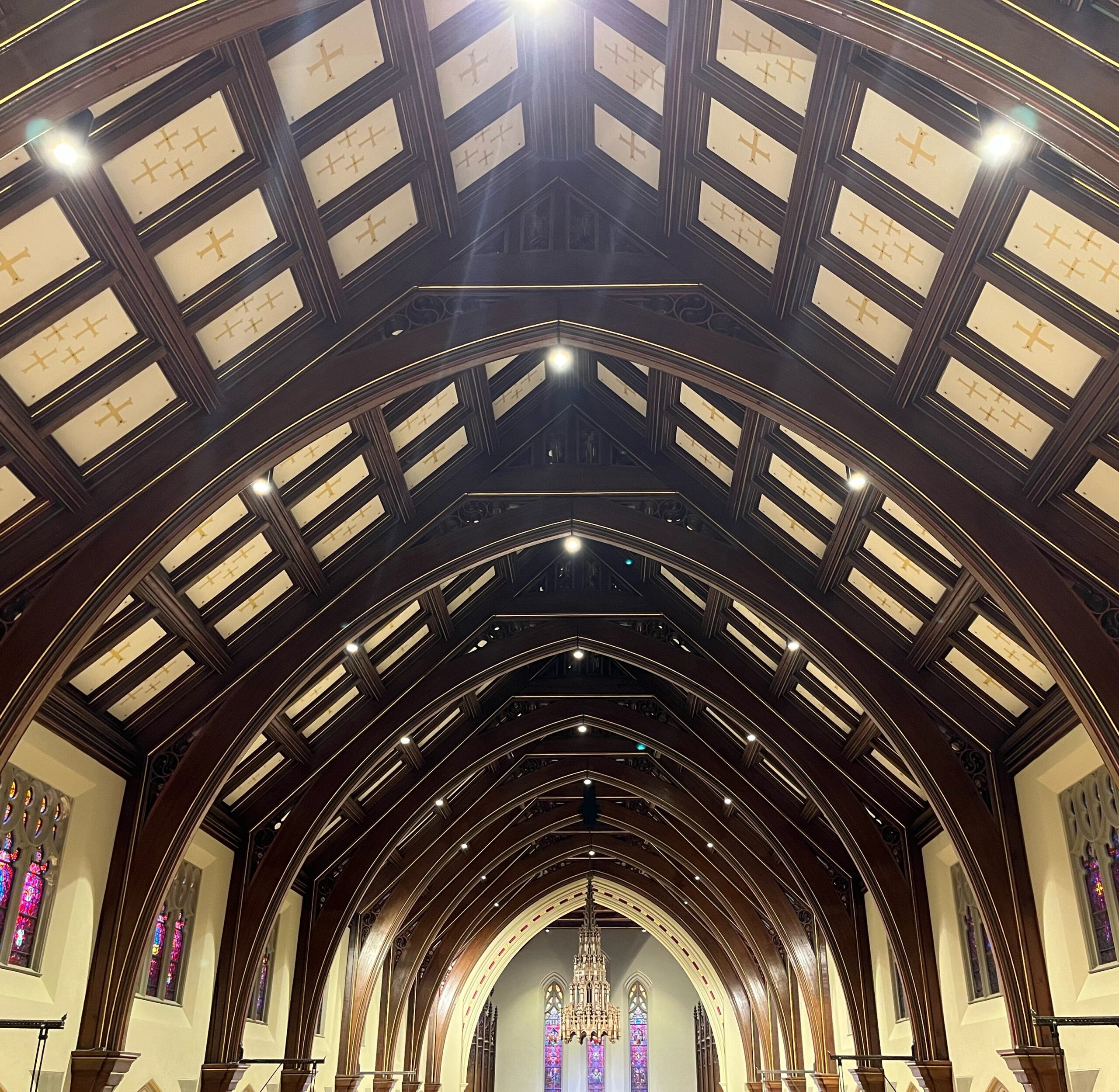Originally published in the GIA Quarterly, Volume 34, Issue 1
The Shape of Your Space
Michael Silhavy
Recently, I have been experiencing a “change of spaces” in both of my places of employment.
By now, I sense most readers of GIA Quarterly know that in January of 2020, GIA acquired World Library Publications. Both publishers were located in the Chicagoland area. Locals were in the habit of saying that say that GIA was near Midway Airport (on the southwest side of the city) and WLP was near O’Hare Airport (on the northwest side).
Because the GIA offices could not accommodate all the new WLP employees, we needed new office space. (This was eight weeks before the onslaught of COVID-19; the idea of working from home seemed unthinkable at that time!) We acquired office space in Oak Park, Illinois, halfway between the two airports. The building was blocks away from some of Frank Lloyd Wright’s most iconic buildings, including his home and studio, and Unity Temple.
Perhaps you have participated in that rare experience of moving into a new worship space. Even more unique is the experience of two or more congregations leaving their worship sites and coming together under a (literal) new roof.
Shared lives, shared space
To a similar yet smaller degree, that is what the GIA and WLP marketing and editorial teams experienced. On January 2, 2020, we marched together into our joint new space. It was a wonderful bonding experience starting out as unfamiliar equals. Happily, many of the employees knew each other, some from making music together in parishes throughout the archdiocese. The large office building had a somewhat clinically cold feel to it; accountants, counselors, real estate agents, and financial planners suddenly had new neighbors: music engravers and editors.
Eight weeks later, COVID-19 found us all working at home.
After nearly two years, it was time to return a more communal work environment. But during that time, the editorial and marketing departments discovered they could work successfully from home.
We found ourselves on the move again, this time to a building a block or two away, complete with a recording studio. Individual offices were no longer needed; the new offices became shared spaces for individual or group project work. The new and current location is a shared work space with other companies and includes a generous amount of common space.
Here too, our floor mates come from varied professions: insurance brokers, lawyers, real estate agents, and marketing consultants. Yet the shared kitchen, dining, and social spaces allow us to enter into contact with each other. This is especially true among the GIA-WLP employees.
The experience of working in new buildings and later being forced to maintain a work office required a new way of doing things. The location, the space, dictated how I and others would function.
How space affects our choices
In the midst of all this, I took a new church position. I traded a beautifully renovated, slightly sparse, intimate space with an angry little German-influenced organ for a French Gothic jewel box with immense stain-glassed windows and a slightly tubby French-inspired organ. The buildings and organs could not be more different.
The liturgy needed to be celebrated different ways in the two different spaces. Processions took longer in the second space, and even with the same amount of communicants, a second communion song was sometimes required. Both spaces had a pipe organ in the loft and a grand piano up front. In the first worship space, I had plenty of time to play the opening hymn on the organ and make it to the piano downstairs for the Gloria. In the second worship space, this was not always possible.
I appreciated those presiders who took a little extra time to welcome people and introduce the day’s liturgy after making the Sign of the Cross. Even spoken texts were affected by the two different liturgical spaces. The smaller, “cleaner” space seemed to benefit from shorter, more direct intercessions during the Universal Prayer; the larger space seemed to demand a longer, if not more florid, type of intercession.
I offer these personal reflections as a lengthy preamble to the topic of this article. It’s something we inherently know but rarely articulate: we are affected by the space around us.
While the church’s liturgical documents address how those who assemble for worship and the liturgical space “work” together, perhaps the best summation of how people and places interact comes from an unlikely source for our liturgical purposes. Sir Winston Churchill delivered an address to the House of Lords in October 1943, responding to the 1941 bombing and destruction of the House of Commons. Churchill asked that the building be rebuilt exactly as it had stood, noting, “We shape our buildings; thereafter they shape us.”
Before asking you to do a quick survey of the many spaces in which you dwell—nave, sanctuary, sacristy, music space, music office, prayer space—I want to mention an element of space that has recently caught my attention: accessibility. My new parish—one of four in the same suburb of Chicago—is proud of its accessibility features. The parish offices, social spaces, and worship site have ramps to assist those in wheelchairs and for whom stairs pose a challenge.
Many parishes can boast of the same accommodations. Nonetheless, I’m afraid there’s a growing phenomenon that a pleasant voice and commitment to regular attendance are not the only requirements for music ministry membership. It seems that the ability to climb the choir loft stairs or front music ministry area is also a prerequisite to membership. As choir members age, the need for accessible music spaces becomes even more necessary. This is yet another example of space shaping the way the liturgy enfolds by virtue of space determining who can fully participate in the space.
Reflecting on the spaces we inhabit
I invite you to consider these distinct spaces so that you can reflect upon how they shape and form your assembly, your liturgical ministers, and yourself.
Your parish office
When was the last time you gave your parish office a good cleaning? Has it become a storeroom of sorts? Has the parish provided you with everything you need to adequately accomplish your work? Forgive me for asking, but does your office appear as a professional workspace? Are wedding couples and grieving families comfortable in your office? Is it a space you can settle into, allowing you to be creative and inspired? Is it a life-giving space, allowing you to function at your best?
Your prayer space
Do you have a personal prayer space? Have you set up a prayer place at home? Have you discovered a place for reflection or prayer in your worship space that you can call your own? Is your office seen as a sacred place for your holy work? Where can you escape to when you need to prepare, wind down, and offer a prayer of supplication or thanks in the midst of your work?
Your music space
Does your music space honor your music ministers—meaning, is it clean, organized, and functional? If the music space is visible to members of the assembly, is it a distraction due to too many music stands, microphone stands, and stacks of music haphazardly stored in the space? To what degree is your music space seen as part of the assembly’s space? Both the choir loft and the up-front music space—delineated by a phalanx of microphone stands and music stands—run the risk of separating musicians from the assembly.
Your worship space
To be clear: the assembly is the first liturgical ministry to be considered among all others, and the assembly is the principal choir of the parish. But have you considered the times when the building might deserve special consideration?
Is your worship space telling you something?
While the assembly’s participation, scriptures, and the liturgical year dictate the way music is chosen, what does your building demand? Are there styles of music that your congregation needs to experience based on what works best in the building? We’ve all experienced the frustrations of a building working against our music programming.
A space might have too much carpeting, thereby creating an excessively dry acoustic. Individual members of the assembly feel like they are the only ones singing. Choral music comes across as “dead” without a halo of reverberation surrounding it. Likewise, there are the occasional spaces with too much reverberation. Highly rhythmic music may be experienced as blurred, and texts may not be intelligible.
Worship is not a purely aesthetic experience, yet it is an experience nonetheless. Are there ways for your congregation to have different sonic experiences in the same worship space? Have you experimented with choirs and instruments in different parts of the worship space?
My relative newness in my two workspaces affords me the joy of creating comfortable places in which to work. Treat yourself sometime soon to a walk through your spaces, and assess what needs to change. We can’t help being affected by the space in which we find ourselves. What type of spaces can you create for yourself, your ministers, and your assembly to be at their very best?
Michael Silhavy is the senior project editor for GIA Publications, Inc. Contact him at [email protected].







